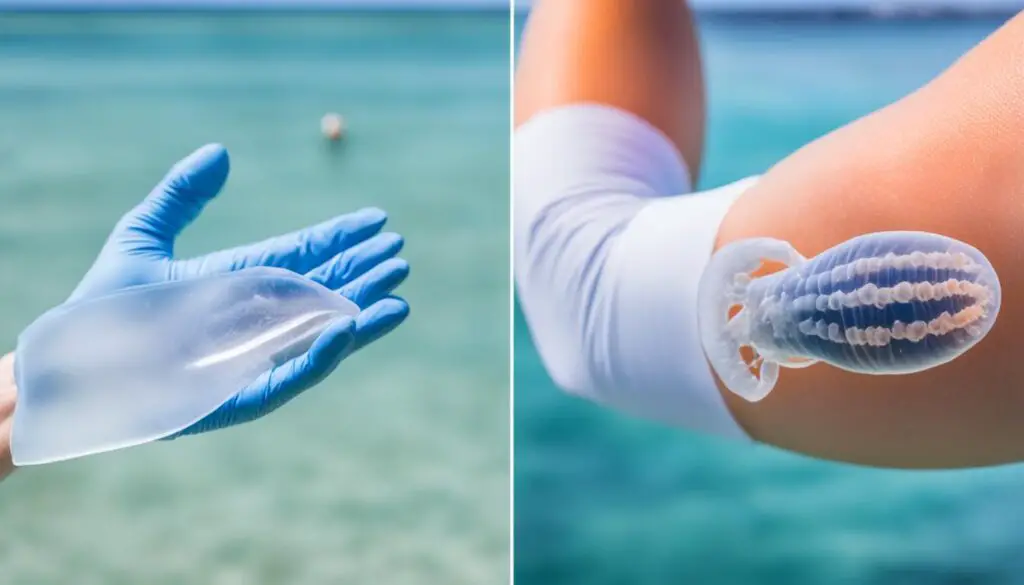Planning your next beach trip? Think about whether jellyfish are a danger to humans. These ancient sea creatures can be a threat, especially in warm months when they’re often seen near the coast. Knowing how their stings can affect you and following safety tips can help you enjoy the beach safely.
Beach trips can turn scary if you meet jellyfish. By understanding their behavior and risks, you can lower the chance of an encounter. This guide will give you key info to help you stay safe during your beach adventures.
Understanding Jellyfish: An Ancient Marine Creature
Jellyfish have been around for millions of years. They come in many species, each with its own special traits. Learning about these species helps us understand their role in the ocean.
Jellyfish Species and Their Characteristics
There are many jellyfish in the world’s oceans, each with its own look. Some of the most interesting types include:
- Box Jellyfish: These have a cube-shaped body and very strong venom, making them dangerous to humans.
- Portuguese Man-of-War: This is not really a jellyfish but a group of animals that can sting with their long tentacles.
- Lion’s Mane Jellyfish: The biggest jellyfish, known for its long tentacles, lives in cold water.
Learning about jellyfish shows how complex and diverse they are. Some are safe and help the ocean’s food chain. Others can be dangerous because of their stings.
The Lifespan and Habitats of Jellyfish
Jellyfish live different lengths of time. Some don’t even make it a year, while others can live for years. They live in many places, such as:
| Species | Lifespan | Common Habitats |
|---|---|---|
| Box Jellyfish | Up to 1 year | Tropical waters |
| Portuguese Man-of-War | 1 year (tentacles last longer) | Warm coastal areas |
| Lion’s Mane Jellyfish | Up to 5 years | Cold waters, temperate regions |
In conclusion, jellyfish are key to the ocean’s balance. By learning about them, we can see how important they are.
Are Jellyfish Dangerous to Humans?
Jellyfish are fascinating sea creatures known for their unique looks and many species. You might ask, are jellyfish dangerous to humans? It’s important to know the risks of different jellyfish types for ocean lovers.
Common Types of Jellyfish and Their Risks
There are many types of jellyfish, each with its own danger level. The box jellyfish is especially dangerous. Its venom can cause a lot of pain, paralysis, and even death. Other jellyfish, like the moon jellyfish, sting but are less harmful, causing only mild discomfort. Here’s a quick look at these common types:
| Jellyfish Species | Venom Severity | Common Effects |
|---|---|---|
| Box Jellyfish | High | Severe pain, cardiac arrest |
| Lion’s Mane Jellyfish | Medium | Pain, redness, swelling |
| Moon Jellyfish | Low | Mild irritation, itching |
Understanding Jellyfish Venom and Its Effects
Jellyfish are dangerous because of their venom, which comes from cells called nematocysts. When their tentacles touch skin, these cells release toxins. These toxins can affect the nervous system and cause symptoms. People with health issues, young kids, and the elderly might react worse. So, knowing about jellyfish at the beach can help you stay safe.
What Happens During a Jellyfish Sting?
Knowing what happens when you get stung by a jellyfish can help you act fast. When you touch a jellyfish’s tentacles, your skin might feel burning, itch, swell, and hurt a lot. These feelings can change based on the jellyfish type and how your body reacts.
Symptoms of Jellyfish Stings
Everyone reacts differently to jellyfish stings. You might feel:
- Intense burning or stinging
- Redness and swelling at the sting site
- Itching that can persist even after initial pain subsides
- Radiating pain that may extend beyond the sting area
Some people might also get sick from the sting. This can include:
- Nausea and vomiting
- Headaches
- Difficulty breathing
How Stings Affect Different Individuals
How you react to a jellyfish sting can depend on many things. Your health before the sting and the jellyfish type matter a lot. Kids and people with health issues might feel worse because their bodies react differently.
Young kids are especially at risk and need extra care when near jellyfish.
| Reaction Type | Mild Symptoms | Severe Symptoms |
|---|---|---|
| Duration | Minutes to Hours | Hours to Days |
| Pain Level | Low to Moderate | High |
| Potential Complications | Minimal | Allergic Reactions, Anaphylaxis |
Treatment for Jellyfish Stings
A jellyfish sting can hurt and cause discomfort. It’s important to know how to treat it right. Following the right steps can lessen the pain. Knowing what to do right after can keep you safe.
First Aid Steps for Jellyfish Stings
Here’s what to do if you get stung by a jellyfish:
- Rinse the affected area with vinegar to neutralize the venom.
- Use tweezers to gently remove any jellyfish tentacles still attached to the skin.
- Soak the sting site in hot water for 20-45 minutes to relieve pain.
- Avoid rinsing with fresh water, as this may cause the nematocysts to release more venom.
- Do not scrub the site to prevent further irritation.
When to Seek Emergency Medical Help
Get medical help right away if you have severe symptoms after a sting. Watch out for these signs:
- Difficulty breathing
- Swelling or tightness in the throat or mouth
- Chest pain
- Rapid heart rate
- Fainting or dizziness
Follow these steps for the best treatment. If reactions are severe, call emergency services without delay.

| Action | Purpose |
|---|---|
| Rinse with vinegar | Neutralizes venom |
| Remove tentacles with tweezers | Prevents further venom release |
| Soak in hot water | Reduces pain |
| Seek medical help | Treats severe reactions |
Preventing Jellyfish Stings
Enjoying the ocean can be fun, but it’s key to know how to avoid jellyfish stings. By following good jellyfish safety tips, you can lower your risk of getting stung. This way, you can have a great time in the water.
Jellyfish Safety Tips for Swimmers
When you’re in the water, it’s important to be alert and know what’s around you. Here are some tips to keep you safe from jellyfish:
- Swim in areas with lifeguards to keep an eye on things.
- Look up beach conditions before you go in the water to see if there are jellyfish around.
- Don’t swim when jellyfish are most active, usually in the warmer months.
- Keep closer to the shore where jellyfish are less likely to be found.
Importance of Protective Clothing and Gear
Wearing the right clothes and gear can really help prevent jellyfish stings. Here’s why you should think about it:
- Wetsuits or skin suits act as a shield against jellyfish tentacles.
- Footwear keeps your feet safe from jellyfish in shallow water.
- Rash guards and other swim gear reduce how much skin is exposed.
Recognizing High-Risk Areas and Seasons
Knowing where and when to swim is key to avoiding dangerous jellyfish. By understanding seasonal patterns and specific beach locations, you can stay safe. Jellyfish are more common in warm waters and bloom in summer, so it’s important to know when and where they appear.
Seasonal Jellyfish Blooms and Their Patterns
Jellyfish blooms happen due to temperature, salinity, and nutrient levels. These conditions are more common in warmer weather, especially in late spring and summer. Keep an eye on local reports to know when jellyfish are around. This helps you decide when to swim and how to prepare for jellyfish.
Identifying Beaches with Jellyfish Risks
Be aware of signs and advisories at the beach for jellyfish activity. Many beaches have warning flags or health advisories about jellyfish. Talking to lifeguards or local authorities can also give you the latest info. By knowing where and when jellyfish are likely to be, you can swim safely and enjoy the beach.









